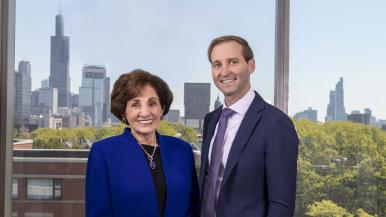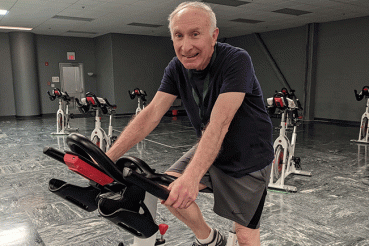When Kathy Patinkin noticed a small, red growth on her nose, she mentioned it to her doctor. After not getting clear answers at several hospitals, Kathy came to Rush University Medical Center where a dermatologist diagnosed her with basal cell carcinoma, the most common form of skin cancer.
While basal cell carcinoma is often very treatable and rarely spreads to other parts of the body, it can be disfiguring.
“Basal cell carcinoma most commonly occurs on the face and other sun-exposed areas,” says facial plastic surgeon Peter Revenaugh, MD, who specializes in skin cancer facial reconstruction. “It can be sneaky in terms of how big the cancer is. While it may look small on the surface, it can often extend further into the tissue. And that was the case with Kathy.”
A care plan
Kathy’s dermatologist planned to remove the cancer with Mohs surgery, one of the most effective procedures for removing this type of skin cancer. But because the cancer had extended so far into the surrounding tissue, Kathy would be left with a 3-centimeter wound on her nose. Her dermatologist partnered with Revenaugh to put together a comprehensive care plan that included nasal reconstruction to address the wound.
“This is a very cosmetically significant part of the face, and it is important to recognize the implications of removing something on that part of the face because there could be major problems and disfigurement,” says Revenaugh. “In Kathy’s case, the skin cancer involved a large portion of her nose and just removing the cancer without reconstruction would have left her with a major distortion on her face.”
Kathy’s team explained everything to her, every step of the way from the moment she came to Rush.
“I’ll never forget the day I met Dr. Revenaugh,” Kathy says. “I was extremely stressed, and I knew I needed a major surgery on my face, which is scary. When he started explaining what kind of surgery I needed, I told him I really wanted my husband to join us. So, Dr. Revenaugh asked me what my husband looked like and then went out into the waiting room himself to get my husband. It was a small gesture, but it showed me what a wonderful, caring doctor he was. From there, he walked us through everything that would happen in the surgery with such kindness and eased my fears the whole time.”
Kathy was also confident in Revenaugh’s extensive experience in facial reconstruction. In fact, as leaders in the field, Revenaugh and his colleague Ryan Smith, MD, another facial and reconstructive surgeon at Rush, helped write the newest guidelines for providers about best practices for facial reconstruction for patients who have skin cancer.
The surgeries
First, Kathy underwent Mohs surgery, which successfully removed all the cancer. Then, 24 hours later, she had the first stage of nasal reconstruction surgery with a forehead flap procedure.
“In this procedure, we used tissue from Kathy’s forehead to reconstruct the part of her nose where the skin cancer was removed,” says Revenaugh. “The procedure involves rotating skin from the forehead and attaching it to the nose. It’s hard to imagine, but we (temporarily) leave the forehead tissue attached to the nose to aid in blood supply. I describe it to my patients as having what looks like a finger between your forehead and your nose.”
Revenaugh explained every detail of this first phase of reconstruction to Kathy to help her understand what to expect and how she would look. “Dr. Revenaugh showed me pictures of how I would look at every stage, which was really helpful,” says Kathy. “It really did look like I had a finger across my face at first. But he had warned me about this, and nothing was a shock to me because he had prepared me for it.”
After two weeks, Kathy had the second phase of the reconstruction, in which Revenaugh removed the connection and smoothed the skin to make sure it all blended in a seamless way with minimal scarring. Several weeks later, Kathy had a final procedure to help refine the side of her nose to give her a more natural-looking crease between the nostril and her cheek and to match the contours of her face.
Recovery and results
“Recovery for these surgeries is relatively quick, and there isn’t a lot of pain afterward,” says Revenaugh. “Most patients are back on their feet after a day. But there is some swelling. And, of course, there are about three weeks between the first and second phase of the procedure where they have the attachment between the forehead and nose, which can be difficult from an aesthetic perspective. Overall, for major reconstructions like this, it takes about six to eight weeks for people to start looking and feeling back to normal.”
Kathy took about a month off work selling real estate after the surgery. But she slowly got more comfortable being around people as her face started to heal.
“Everything went exactly as Dr. Revenaugh said it would go,” says Kathy. “He never touched me without telling me what he was planning to do and how I would look and feel after it. He was always available to answer my questions and really guided me through this whole ordeal.”
Today, Kathy continues to get regular skin checks to help detect any new skin cancers and you would never know she had major nasal reconstruction. “Everything went great, and I look fine,” she says. “There is a tiny scar on my forehead and my nose looks completely normal. It’s pretty incredible.”




